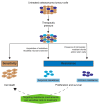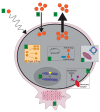Targeting Molecular Mechanisms Underlying Treatment Efficacy and Resistance in Osteosarcoma: A Review of Current and Future Strategies
- PMID: 32961800
- PMCID: PMC7555161
- DOI: 10.3390/ijms21186885
Targeting Molecular Mechanisms Underlying Treatment Efficacy and Resistance in Osteosarcoma: A Review of Current and Future Strategies
Abstract
Osteosarcoma is the most common primary malignant bone tumour in children and adolescents. Due to micrometastatic spread, radical surgery alone rarely results in cure. Introduction of combination chemotherapy in the 1970s, however, dramatically increased overall survival rates from 20% to approximately 70%. Unfortunately, large clinical trials aiming to intensify treatment in the past decades have failed to achieve higher cure rates. In this review, we revisit how the heterogenous nature of osteosarcoma as well as acquired and intrinsic resistance to chemotherapy can account for stagnation in therapy improvement. We summarise current osteosarcoma treatment strategies focusing on molecular determinants of treatment susceptibility and resistance. Understanding therapy susceptibility and resistance provides a basis for rational therapy betterment for both identifying patients that might be cured with less toxic interventions and targeting resistance mechanisms to sensitise resistant osteosarcoma to conventional therapies.
Keywords: chemoresistance; cisplatin; combination chemotherapy; doxorubicin; drug synergy; ifosfamide; immunotherapy; methotrexate; osteosarcoma; tumour microenvironment.
Conflict of interest statement
The authors declare no conflict of interest.
Figures



References
-
- Ottaviani G., Jaffe N., Ottaviani G. The Epidemiology of Osteosarcoma. Cancer Treat. Res. 2009;152:3–13. - PubMed
-
- Gibson T.M., Mostoufi-Moab S., Stratton K.L., Leisenring W.M., Barnea D., Chow E.J., Donaldson S.S., Howell R.M., Hudson M.M., Mahajan A., et al. Temporal patterns in the risk of chronic health conditions in survivors of childhood cancer diagnosed 1970–99: A report from the Childhood Cancer Survivor Study cohort. Lancet Oncol. 2018;19:1590–1601. doi: 10.1016/S1470-2045(18)30537-0. - DOI - PMC - PubMed
Publication types
MeSH terms
Grants and funding
LinkOut - more resources
Full Text Sources
Medical
Miscellaneous

